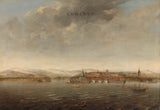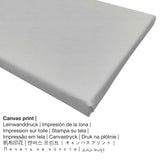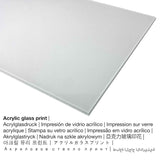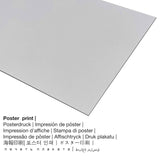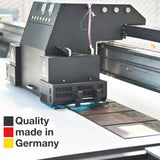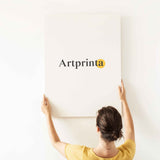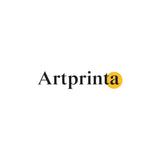Amaghị, 1662 - Echiche nke Cochin na Malabar Coast nke India - ọmarịcha nka
Ụtụ gụnyere. Mbupu gbakọrọ na ndenye ọpụpụ.
View of Cochin on the Malabar Coast of India dị ka ihe nka ebipụta
In 1662 Unknown painted this 17th century artwork. The artpiece forms part of the art collection of Rijksmuseum na Amsterdam, Netherlands. Site n'ikike nke: Rijksmuseum (ikike ngalaba ọha).The creditline of the artpiece is the following: . The alignment is in landscape format with a side ratio of 3: 2, nke pụtara na ogologo bụ 50% ogologo karịa obosara.
Nhọrọ akụrụngwa ngwaahịa
N'ime ndetu ndetu ngwaahịa ị nwere ike ịhọrọ nha na ihe gị n'otu n'otu. Ị nwere ike ịhọrọ nha na ihe kachasị amasị gị n'ime nhọrọ ndị a:
- Kwaaji: A printed canvas, which shall not be mistaken with a canvas painting, is a digital replica applied directly on canvas material. A canvas generates the plastic effect of three dimensionality. Further, a canvas print makes a charming, pleasant atmosphere. Canvas Prints have the advantage of being low in weight. This means, it is quite simple to hang up the Canvas print without the support of any wall-mounts. Because of thata canvas print is suited for all types of walls.
- Mbipụta nke aluminom: An Aluminium Dibond print is a print with an impressive depth - for a modern look and a non-reflective surface structure. The Aluminium Dibond Print is the excellent start to art prints with aluminum. For our Direct Print On Aluminum Dibond, we print your artpiece onto the aluminium white-primed surface. The bright and white parts of the artpiece shine with a silky gloss but without glow. The colors of the print are luminous, the fine details of the print appear very clear, and you can literally feel the matte appearance of the fine art print.
- Mbipụta iko acrylic (nke nwere ezigbo mkpuchi iko): An acrylic glass print, often denoted as a plexiglass print, will transform the original into beautiful home decoration. Your own copy of the artwork will be custom-made thanks to modern UV direct print technology. The image effect of this are vibrant, impressive colors.
- Akwụkwọ mmado ebipụtara (akwa akwa akwa): Our poster print is a UV printed flat canvas with a granular surface texture. It is suited for framing the art copy using a customized frame. Please note, that depending on the absolute size of the poster we add a white margin of around 2-6cm around the painting to facilitate the framing with your custom frame.
Ederede iwu: We try everythig possible in order to depict our products as precisely as it is possible and to illustrate them visually. Please bear in mind that the tone of the printing material, as well as the printing can differ slightly from the image on the monitor. Depending on your settings of your screen and the condition of the surface, colors may not be printed 100% realistically. Because all our art prints are processed and printed by hand, there may as well be minor differences in the size and exact position of the motif.
Ozi ihe ahaziri ahazi
| Nkewa ngwaahịa: | mmepụta nka |
| Mmeputakwa: | mmeputakwa n'ụdị dijitalụ |
| Production usoro: | Mbipụta UV ozugbo (mbipụta dijitalụ) |
| Mmalite ngwaahịa: | Germany |
| Stockdị ngwaahịa: | a na-achọ |
| Ojiji ngwaahịa: | mgbidi mgbidi, mgbidi gallery |
| Ndepụta: | nhazi odida obodo |
| Ụdị anya: | ogologo: obosara 3:2 |
| Akụkụ akụkụ pụtara: | ogologo bụ 50% ogologo karịa obosara |
| Materials: | akwụkwọ mmado (akwụkwọ kwaaji), mbipụta ọla (aluminium dibond), mbipụta iko acrylic (nke nwere ezigbo mkpuchi iko), mbipụta akwụkwọ. |
| Nhọrọ nha nha mbipụta kanvas (akwa akwa na etiti ihe ndọtị): | 30x20cm - 12x8", 60x40cm - 24x16", 90x60cm - 35x24", 120x80cm - 47x31", 150x100cm - 59x39" |
| Mbipụta iko acrylic (nke nwere ezigbo mkpuchi iko): | 30x20cm - 12x8", 60x40cm - 24x16", 90x60cm - 35x24", 120x80cm - 47x31" |
| Mbipụta akwụkwọ mmado (akwụkwọ kwaaji): | 60x40cm - 24x16", 90x60cm - 35x24", 120x80cm - 47x31" |
| Ụdị nha ebipụta aluminom: | 30x20cm - 12x8", 60x40cm - 24x16", 90x60cm - 35x24", 120x80cm - 47x31" |
| Nhazi mmeputa nka nka: | enweghị etiti |
Data nka ahaziri
| Aha nke ihe nka: | "View of Cochin on the Malabar Coast of India" |
| Nchịkọta nke ọrụ nka: | sere |
| Otu izugbe: | nka ochie |
| Century: | 17th narị afọ |
| Afọ nka: | 1662 |
| Afọ nka: | karịa afọ 350 |
| Ụlọ ihe ngosi nka / mkpokọta: | Rijksmuseum |
| Ebe ngosi nka: | Amsterdam, Netherlands |
| URL webụ: | Rijksmuseum |
| Ụdị nka nka: | ngalaba ọha |
| Site n'aka: | Rijksmuseum |
Ozi ndabere izugbe gbasara onye na-ese ihe
| aha: | Unknown |
| Ọrụ: | onye na-ese ihe |
| nhazi ọkwa: | nna ukwu ochie |
© Nwebiisinka | www.artprinta.com (Artprinta)
Ozi ihe osise dị ka enyere site na ụlọ ngosi nka (© - site na Rijksmuseum - Rijksmuseum)
Cochin (now Kochi), on India’s southwest coast, was a Portuguese fortified town from 1500. In 1663 the Dutch East India Company captured the town for its pepper trade. The Dutch reduced the fort by two thirds so that it would be easier to defend. Portuguese monasteries and churches were converted into warehouses.

